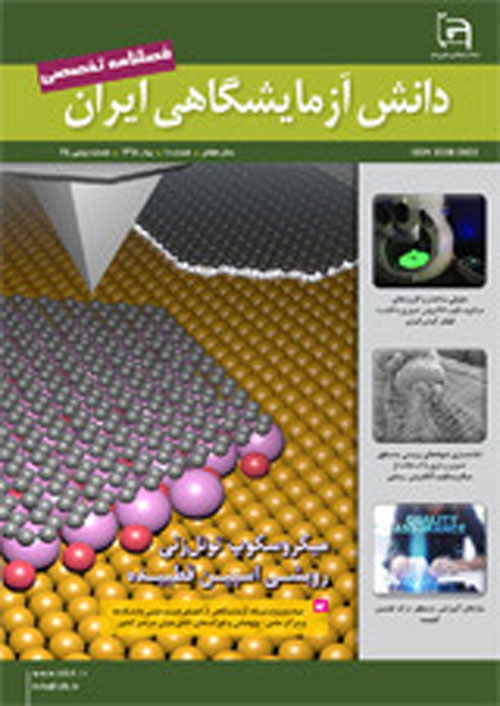فهرست مطالب

مجله دانش آزمایشگاهی ایران
سال هفتم شماره 2 (پیاپی 26، تابستان 1398)
- تاریخ انتشار: 1398/06/12
- تعداد عناوین: 8
- اخبار
-
انتقال تجربیات آزمایشگاه های آذربایجان شرقی برای مدیران شبکه آزمایشگاهی انجام شد / گردهم آیی مدیران مراکز عضو شبکه آزمایشگاهی فناوری های راهبردی به منظور آشنایی با توانمندی و خدمات آزمایشگاه های آذربایجان شرقی در تبریز برگزار شد.صفحه 2
- استاندارد
-
مشخصه یابی نانومواد به وسیله میکروسکوپ الکترونی عبوری (TEM) / استاندارد ملی 21950-2صفحه 6
- مقالات
-
صفحه 7
میکروسکوپ تداخل کوانتومی ابررسانای روبشی 5 برای انداز هگیری شار ذرات و همچنین بررسی ابررسانایی و خواص فرومغناطیس مورد استفاده قرار گرفته است. میکروسکوپ ابررسانای روبشی 6 ابزاری برای تهیه تصویر از میدان های مغناطیسی سطحی است. تقریبا هر سیگنال الکتریکی یا مغناطیسی با فرکانس پایین که قادر به تبدیل سیگنال شار مغناطیسی باشد، با این میکروسکوپ قابل شناسایی است. کاربردهای میکروسکوپ تداخل کوانتومی ابررسانای روبشی عبارتند از مطالعه خواص مغناطیسی و الکترونیکی مواد، جستجوی منابع انرژی حرارتی در خاک، مطالعات پالئومغناطیسی، تحقیقات بیومغناطیس، انداز هگیری دما و در نهایت، شناسایی و تعیین ساختارهای مغناطیسی سطح زمین و دری
کلیدواژگان: میکروسکوپ تداخل کوانتومی ابررسانا، پیوند جوزفسون، میدان و شار مغناطیسی، تفکی کپذیری فضایی -
صفحه 49
-
Page 7
The Scanning Superconducting Quantum Interference Device Microscopy (SSM) has been used to measure the particle flux, as well as the investigation of superconductivity and ferromagnetic properties. SSM is a tool to capture the image of magnetic contaminants on nonmagnetic surfaces. Almost any low-frequency electrical or magnetic signal capable of converting to a magnetic flux signal is detectable with this microscope. Scanning Superconducting Quantum Interference Device Microscopy (Scanning SQUID Microscopy) applications include study of magnetic and electronic properties of materials, search for thermal energy sources of soil, paleomagnetic studies, biomagnetic research, measuring the temperature and finally identifying and detecting the magnetic structures of the surface on the ground and sea.
Keywords: Josephson junction, spatial resolution, Scanning Superconducting QuantumInterference Device Microscopy (ScanningSQUID Microscopy) -
Page 15
Carbohydrates (carbon monoxide or sugars) are a type of biological molecule that is chemically known as polyhydroxyaldehyde or polyhydroxycotone. Today, modern methods are used to isolate and extract sugars. In this paper, the methods of membrane extraction and filtration systems in the sugar industry, extracted with protected membrane, extracted with pressurized fluid - and using hot water, extracted with the help of microwave waves, extraction with supercritical solvent, extraction by field Strong pulsed electric pulses, using ultrasonic or ultrasonic waves to extract more sugars; along with presenting the latest research and available papers with the aim of identifying the best extraction method with high yields of the desirable sweetener. All the techniques described have advantages and disadvantages. In all of these methods, the amount of solvent consumed is low or non-used, faster, less toxic, high sensitivity and easier to extract than conventional methods.Due to the lack of sufficient technical knowledge and information, today, the need to address this important issue and the creation of a suitable platform for the participation of the more knowledgeable people of the country is felt more and more. In this paper, with describing the activities of the International Organization for Standardization (ISO), the process of developing international standards and participation in this activity is described.
Keywords: Extraction, Carbohydrates, Sweeteners, Separation -
The effect of electromagnetic waves on human body tissues and organisms and the ways to protect themPage 41
What are electromagnetic waves? How are they created and how can they move? How can we widely understand and organize them? What are the different properties of their relationship with electrical and magnetic effects? In this paper, we intend to investigate the effects of electromagnetic waves on humans and living organisms by answering these questions. In the beginning, the types of electromagnetic waves are classified in terms of frequency range and are investigated in terms of ionization and non-ionization. It then refers to the general principles of protection against radiation. The result of the present study is that if the prescribed standards are met, the radio and microwave radio in the public environment do not pose a threat to humans.
Keywords: electromagnetic, electrical, magnetic, waves, frequency


